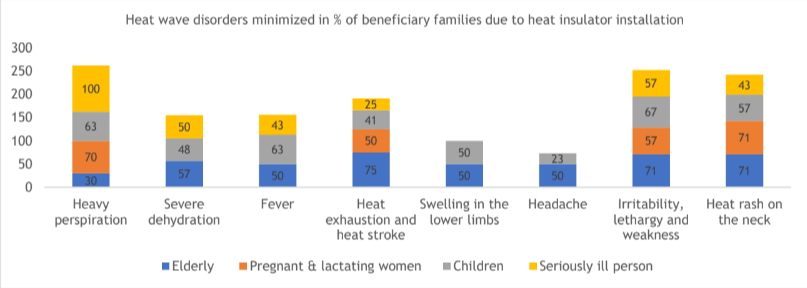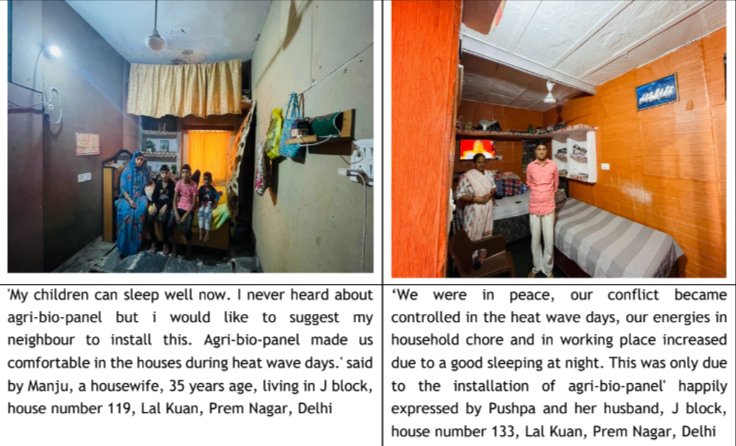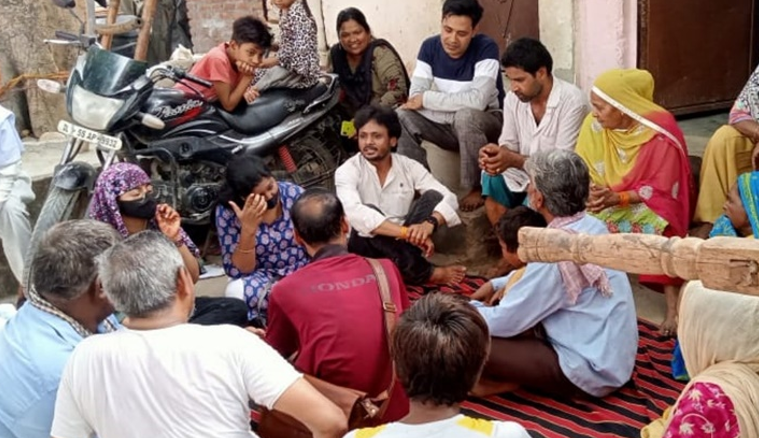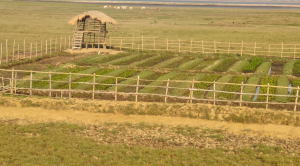Heat Wave Resilient Houses in Delhi Slums
Executive summary:
Heat wave become the most violent climate crisis in the last decades. The number of casualties encountered by heat
wave had been consistently increased since 90’s. From 3rd March to 18th April 2023 heat wave was declared in 11 states
and union territories by Indian Meteorological Department. A total of 252 deaths were reported in the first half of 2023
due to this massive crisis. This heat wave was highly dominated in northern states of India where Delhi was massively
impacted. This impact was highly visible in most of the street vendors, construction workers and other urban informal
workers who stayed out of the house for their job in most of the daytime. The heat wave crisis in urban informal workers
working outside has been documented in several reports, journals etc. But the heat wave emergency in climate
vulnerable urban poor communities, especially inside the houses has been focussed on very few documents.
Most of the houses in urban informal settlement is constructed by fragile construction & combustible materials,
asbestos/ tin roof etc. Houses have very low ventilation; this accumulates extreme heat in the summer, an average 35-
to-40-degree Celsius temperature occurs inhouse. Due to this heat wave severity is more visible inside the slum houses
compared to outside. Acute dehydration, irritability, lethargy & weakness, fever, heat rash & heat stroke are very
common in most of the children below twelve years. Heavy perspiration accompanied with critical maternity health
issues are visible in pregnant & lactation women. Survivability in the houses during the heat wave days is a big challenge
for elderly. This extreme hot in-house situation led to the slum dwellers to frequent conflict & other violences. The
heat wave pains in the urban poor community has become hardly minimized despite of emergency responses like
organizing water points, awareness etc by the local administration.
This heat wave crisis was addressed by the thematic team of Indo Global Social Service Society (IGSSS) through an
infrastructural innovation, piloted in the selected four slums of Delhi. In this pilot, preparedness measures were taken;
low cost Agri-bio-panels, a heat insulator was installed in-house; minimized heat wave pains and gave relief, comfortable
life & survivability to the urban poor inside the houses. IGSSS was the pioneer in introducing this strategy which was
prioritized by the urban poor community for replication in the long run.
This action research literature will give us an understanding on heat wave impacts inside the houses of urban poor
community and the strategy which was successfully piloted for minimizing their heat wave pains inside the houses.


Objecttive of the innovation:
Identifying and addressing heat wave impacts through structural and non-structural preparedness measures in urban
poor community
Strategy:
- Preparedness- The innovation prioritized several preparedness initiatives at family and community level to minimize
the heat wave impacts in the slum dwellers. The preparedness measures were categorized in structural and non-
structural measures. The non-structural measures were rampant awareness, emergency response in heat wave days, - Incentivization to environment- The strategy was, recycling of waste straw to process the heat insulator panels or
agri-bio-panels. This addressed seasonal stubble burning issues. These panels were fixed on the walls and roofs to
minimize the inhouse temperature in the slum houses. This panel was a strong heat insulator; fire, termite, sound
and moisture proof; had negative carbon footprint hence 100% incentivizing to climate and environment. - Partnership & collaboration- IGSSS was the pioneer organization to take this initiative on 2022 in urban settlement
through a partnership with Strawcture Eco, a knowledge resource organization. This innovation was undertaken by
IGSSS in collaboration with ELRHA and SEEDs India. - Community leadership- Priority was given to the interest and experience of urban poor community. Strengthening
and capacity building to slum youth developed their leadership to take decisions in the innovation. - Networking- Coalition with local peer civil society organizations for a consensus building on heat wave preparedness
was another strategy. This coalition led to awareness and heat wave emergency responses in the neighbouring non
project slums. - Liaison- Liaison with the local administration would result in financial allotment from the municipal budget to
replicate this innovation.
Process:
The process was divided into three sections.
Pre- installation of agri-bio-panel-
- Orienting slum dwellers on the innovation through discussions, meetings etc.
- Identifying active, enthused youth leaders and their capacity building to give voluntarily service in the innovation.
- Undertaking a rapid assessment and finalizing slum houses or beneficiary families with the knowledge resource
organization. Prioritizing the houses with brick walls and constructed or asbestos roof which were able to hold the
agri-bio-panel. - Surveying the beneficiary families to assess the baseline or pre-installation situation and taking measurement of
the walls and roof for calculating the amount of agri-bio-panel required for each house. Also taking the indoor
temperature of each house at pre-installation - Undertaking some heat wave preparedness measures at community level under the leadership of youth volunteers,
for example- Sensitizing on heat wave and heat wave preparedness through posters; announcement through micro/
megaphone, tablo car, audio-visuals etc - Organizing small stalls in transit points for serving cold water, ORS and shade support to the pedestrians.
- Dialoguing with the local administration, for immediate actions like tube well repairing, organizing water
tanks etc and long-term actions like localizing a heat wave action plan
- Sensitizing on heat wave and heat wave preparedness through posters; announcement through micro/
- Consensus building with the local peer civil society organizations on emergency responses during heat wave days.
Installation:
- Signing a consent with the beneficiary families before starting installation
- Fixing of the agri-bio-panels on the walls roofs of the houses with the technical support from knowledge resource
organization. - Monitoring and managing the installation works in the slum under the leadership of youth volunteers.

Installation of heat insulator on the walls inside houses
Post installation:
- Handing over the house to the beneficiaries without any damage and distortion
- Taking feedback and endline information from the beneficiary families.
- Taking the indoor temperature of each house at post-installation
- Displaying the installation to the local admin representatives and peer civil society organizations for upscale and
replication.
Sampling:
A total 30 houses were selected for the heat insulator panel installation from four different slums in Delhi city for
piloting this initiative.
Result:
- Inhouse temperature became reduced 3 to 4 degree centigrade on an average in all beneficiary households due
to this stallation.in - From the baseline survey of the beneficiary families some common physical disorders were identified in elderly,
children, pregnant lactating women and seriously ill persons, those usually stayed inhouse during the heat wave
days.- Heavy perspiration
- Severe dehydration
- Fever
- Heat exhaustion & heat stroke
- Swelling in the lower limbs
- Headache
- Irritability lethargy & weakness
- Heat rash on neck

It has been revealed from the beneficiary families that,
- 100% seriously ill persons were relieved from heavy perspiration whereas heat exhaustion heat stroke
possibilities reduced in 25% seriously ill persons, during heat wave days due to the installation of heat wave
insulators in houses. - In the post installation of agri-bio-panels during heat wave days in houses 67% children got relief from
irritability, lethargy weakness whereas 23% children considered a sharp decrease in headache. - During heat wave days due to the installation of heat insulator panels in the houses, reduction of frequent
heat rash on neck was visible in 71% pregnant lactating women whereas 50% pregnant lactating women
expressed their relief from heat exhaustion. - During the heat wave days, 75% elderly persons were relieved from heat exhaustion and heat stroke whereas
30% elderly persons said reduction in heavy perspiration. This is due to the inhouse agri-bio-panel installation.
- Heat insulator panel installation led to minimize frequent hospitalization of children, lactating & pregnant women,
elderly and seriously ill persons in the beneficiary families during heat wave days. - Tiredness in household chores became reduced in women of almost 80% beneficiary households. Men of the target
households revealed increase in their energies in working place due to a good sleeping at night in their rooms. - Apart from this, the 100% slum communities became sensitized on the heat wave preparedness measures as the result extreme heat wave fatal cases were not visible within the slum community during heat wave days.
- Overall, the slum communities felt a comfortable situation even in the extreme summer days which resulted in a
harmony and peace within the household members and community.
Scope:
- The slum community is not familiar with the heatwave science, its impact and preparedness measures. Hence there
was a scope for organizing much more sensitization events. - Frequent meeting discussion gave confidence to the slum youth in leading this pilot initiatives in their slums.
- Active involvement of slum youth in this process helped them to grow their skill in installation of the heat insulator
panels in houses. - Dialogue with the local duty bearers led to a possibility to generate municipal allocations for replication.
- In average, each house installation costs INR 26000/- approximately, including the cost of raw materials. Due to this low cost and long-term gain, this innovation raised interest of the community.
- Due to the recycling of waste straw or stubble waste per square meter agri-bio-panel reduces 30 kilo CO2 from
atmosphere. Hence scope to incentivize environment.
Limitation & learning:
- Evacuation of the room to install agri-bio-panel was a challenge for the slum families. Most of the families stayed in
single room, the furniture was kept outside during fixing agri-bio-panel. This became a challenge to them if rains
happened. Hence priority was given to fix the agri-bio-panel in post monsoon. - A conflict raised in the slum dwellers for finalization of the beneficiaries, hence priority was given to those houses
which were identified by the knowledge resource organization. The knowledge resource organization team identified beneficiary houses based on quality of the construction of houses after a rapid assessment. This is the only condition for a successful installation. - Article: Heat Wave Resilient Houses in Delhi Slums
In post installation, any type of perforation or damage caused distortion to the agri-bio-panel, hence proper
handling of the agri-bio-panel was required after the installation. Usually the longevity of the agri-bio-panel was
approximately twenty years without any maintenance cost. A maintenance cost was required if any distortion
happened in the agri-bio-panel.
Recommendation:
Recycling of stubble waste in agri-bio-panel was an innovative technology proposed by the knowledge organization
Strawcture Eco. Using agri-bio-panel inside the room for a heat wave resilient house in slum was the innovation. IGSSS
was the pioneer in building heat wave resilient houses in slums using low cost and community lead strategy which got a
big success. Moreover, involvement of local administration and local peer civil society organization also led to increase
community awareness in heat wave preparedness, emergency heat wave response and resource mobilization to replicate this heat resilient houses. Below are the recommendations from experience of this pilot innovation-
- Replication of this innovative heat resilient houses in the slum community as much as possible. This can address the environmental carbon footprint issue and also increase inhouse resilience of slum community during heat wave days.
- Community leadership through capacity building and strengthening to undertake this innovative technology in slum houses.
- Coalition with local peer civil society organization to disseminate the heat wave preparedness measures to the urban
poor community. - Dialoguing with local duty bearers so that they can give space of this innovation in existing housing allotments from
municipal budget. This is the only way of replication and sustainability of this innovative heat resilient house in the
slums.
Success stories:

Author name : Proshin Ghosh




